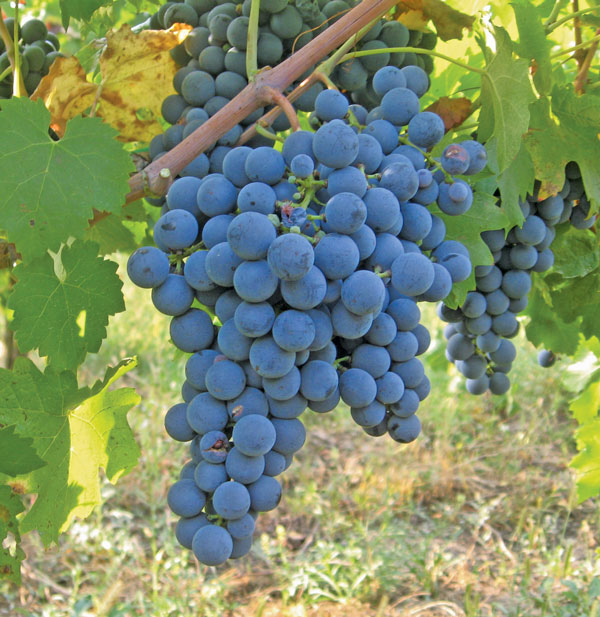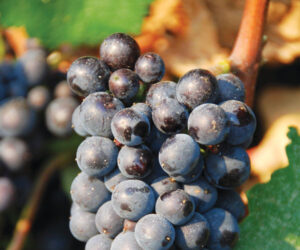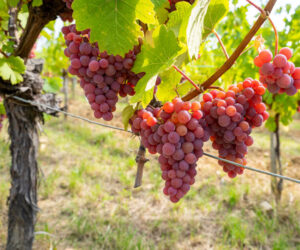Almost ten years ago my wife Polly and I visited the city of Bordeaux in the southwest part of France and toured its famed surrounding wine country. A truly memorable experience that ranged from pop-up wine tastings, gastronomic indulgences, and the much-revered activity of dodging pigeon bombs in the city center. But why the trip was also most memorable is that I got to really understand the region’s geography, soils, grape varieties, and why these specific varieties were grown where they were. Years earlier as a student of wine I couldn’t quite grasp Left Bank versus Right Bank, they were just lines and dots on a map. But there it was right in front of me, and it all started coming together. The sun, the winds, the microclimates, the geology . . . Cabernet Sauvignon, Cabernet Franc, Merlot, Petit Verdot, and Malbec; were all starting to make sense.

But there were more varieties it seemed as I teased through my limited French language skills and our guide telling us that some words just do not translate very well . . . kind of like Inuit language and their 50 words for snow. It made sense with such a long history of wine growing in the region that there had to be more than just the “big five.” Returning home and slightly jet-lagged, I was reading more and understanding more about the region and I came across another red variety that must have been what our hosts were talking about. Certainly not obscure in the wine world, just not a lot of it left in post-Phylloxera Bordeaux, and it blends (pun intended) into the landscape with those big five.
Carménère is an old variety from the Gironde region of France. It is a vigorous red grape varietal with small clusters and medium-sized berries. Its leaves are the typical Bordeaux shape with five slightly overlapping lobes, and an upper leaf sinus with a tooth at the margin. If this sounds like a couple of the other Bordeaux reds, then you are correct. The DNA parentage has recently established that Carménère is a natural cross between Cabernet Franc and Gros Cabernet, an even older variety from the Gironde and the Tarn, which was often confused with Cabernet Franc.
Gros Cabernet is now largely uncultivated, however, the DNA truth seekers have determined that Carménère and Cabernet Franc have a high level on consanguinity, or common ancestry. It turns out that Carménère is both a progeny and great-grandchild of Cabernet Franc, a half sibling of both Cabernet Sauvignon and Merlot. That explains all the confusion between them and what our hosts were talking about on that trip to Bordeaux. The confusion does not stop at Bordeaux, and thanks to the DNA truth seekers, many of the Cabernet Franc and Merlot vines of Italy, Chile, China, and California, were determined to actually be misidentified Carménère. China took it a step further in 1892 and imported cuttings under the name Cabernet Gernischt, German for “mixed Cabernet,” which refers to the broad ampelographic group called Carmenet. And here I thought it was hard to get my head around the family tree I married into!
The DNA parentage has recently established that Carménère is a natural cross between Cabernet Franc and Gros Cabernet . . .
The Phylloxera epidemic of France in the 1860s really changed how the Carmenet ampelographic group was distributed in Bordeaux. Both Malbec and Carménère were widely planted, but in the post-Phylloxera world, Malbec did not graft to rootstock well and Carménère was subject to poor fruit set and inconsistent yields. Thus, their respective vineyard acreage decreased in France . . . only to be introduced in other parts of the world where they both performed very well and made some nice wines. Carménère’s current power base is Chile where it was planted as a field blend with Merlot and, given the long history of ampelographic confusion, most growers probably thought it was all Merlot. Though some writers will debate that the growers did know the difference and they were designated Merlot and Merlot Chileno, the latter name in reference to Carménère.
This varietal flourished in warm, dry climates like those found in Chile, eastern Washington, California, and China. Of these regions, Chile has the lion’s share of vineyard area. The key was the ability to set fruit, something that was not a given in its native Bordeaux, which is largely a maritime environment. Typical to the Carmenet family of grapes, early harvested grapes from this family are notorious for strong notes of herbaceous, capsicum (bell pepper) aromas from elevated methoxypyrazine levels. As the fruit hangs longer, these flavors morph to red berry, black pepper, tomato, and, when the berries are perfectly ripe, blackberry, blueberry, chocolate, coffee, and soy. But at this late stage there is a significant reduction in acidity, which requires adjustment to rebalance the wine. Needless to say, the fruit benefits from longer hang times but the winemaker needs to step in, and where permitted, make appropriate acid adjustments.
So, what is an appropriate acid adjustment? The winemaker must first understand why an acid adjustment is necessary. In the case of Carménère and other varieties that benefit from longer hang times, it has to do with the berry’s main source for carbon. Prior to veraison, the berries use glucose as their main source of carbon for respiration while accumulating malic acid. Ever taken a bite of a green berry before or at veraison? Everyone does once. At veraison, the berry reverses gears and starts to accumulate sugar while now utilizing the malic acid reserves for respiration. These reserves can be depleted significantly, and I have seen little or no malic acid in grape musts at crush. This is why, as winemakers, understanding the pH, acidity, and actual malic acid concentrations in your musts are the key to balanced wine. An understanding of when it is best to make these supplements is beyond the scope of this “Varietal Focus” column but suffice to say, Carménère in warmer climates often will need a little work by the winemaker.
It can be a tannic wine, and also of deep red color. Recent research has indicated that it has a different polyphenolic profile than other Carmenet members. A lot of this interest is not just understanding the color and flavor profiles of the grape, but the correlated potential health benefits associated with polyphenolic compounds: Heart health and cancer prevention. Carménère has very high concentrations of anthocyanins, specifically malvidin, flavonols, quercetin, myricetin, and the flavanols; catechin and epicatechin. All of these compounds increase in the berry as a result of indirect sunlight exposure while they undergo extended hang time. To promote indirect sunlight exposure, strategic leaf pulling on the shady side of the canopy is necessary. As Carménère is classified as a vigorous variety, this is also necessary to promote good airflow through the fruiting, which also promotes good penetration of sprays.
It is important to note that varieties that are high in polyphenolics can also show increased bitterness and perceived astringency.
It is important to note that varieties that are high in polyphenolics can also show increased bitterness and perceived astringency. So when working with these wines careful processing will moderate the extraction of these compounds into the must. At the destemmer/crusher for example, it’s preferable to have the ability to adjust the rollers so that the berries are just fractured as opposed to rollers that macerate the berry and crush the seed. In the study I reviewed for this piece about half of the tannin measured was seed tannin, which is perceived more bitter than astringent. Seed tannin can be mechanically extracted as previously described or extracted by extended maceration of the must. I recommend pressing at seven to ten days. When pressing, watch your press cuts by tasting as the pressure builds. Keep the press fractions separate to possibly blend back in later. I always say, don’t put any more in that you may have to take away later.
Circling back to that Bordeaux trip with my wife. Our hosts drove us all around the region, visiting chateau after chateau. At one chateau, the bookkeeper even came out and tasted with us, as he was bored preparing reports for his ownership group. Everyone needs to unwind sometimes.
Meanwhile the city of Bordeaux proper was undergoing a noisy renaissance of sandblasting the dark molds from the stone buildings. Looking at the newly renovated building facades revealed many old murals hidden by the years. Polly and I enjoyed standing back a little way from the buildings to see it all come together . . . similar to the way the matrix of vineyards and varietals comes together in harmony in Bordeaux and its famed wines. Carménère is one of the many grapes that make this part of France such an amazing wine region. While it may now be better known as a New World grape, its roots are found in Bordeaux.
Carménère Recipe
Ingredients
125 lbs. (57 kg) Carménère fruit
Distilled water
10% potassium metabisulfite (KMBS) solution. (Weigh 10 grams of KMBS, dissolve into about 50 mL of distilled water. When completely dissolved, make up to 100 mL total with distilled water.)
5 g Lallemand D254 yeast
5 g Diammonium phosphate (DAP)
5 g Go-Ferm
5 g Fermaid K (or equivalent yeast nutrient)
Malolactic Fermentation Starter Culture (CHR Hansen or Equivalent)
Other equipment or needs specific to this recipe
15-gallon (57-L) food-grade plastic bucket for primary fermentation
5-gallon (19-L) carboy
1–2 one-gallon (3.8-L) jugs
Racking hoses
Destemmer/crusher
Wine press
Inert gas (nitrogen, argon, or carbon dioxide)
Ability to maintain a fermentation temperature of 81–86 °F (27–32 °C)
Thermometer capable of measuring between 40–110 °F (4–43 °C) in one degree increments.
Pipettes with the ability to add in increments of 1 mL
Tartaric acid – addition rate is based on acid testing results.
Step by Step
- Clean and sanitize all your winemaking tools, supplies and equipment.
- Destem and gently crush the grapes. Transfer the must to your bucket.
- During the transfer, add 15 mL of 10% KMBS solution (This addition is the equivalent of 50 ppm SO2).
- Take a sample of must to test for Brix, acidity, and pH. Keep the results handy. We’ll take this up later.
- Layer the headspace with inert gas and keep covered. Keep in a cool place overnight.
- The next day sprinkle the Fermaid K directly to the must and mix well.
- Go back to those lab results you took yesterday. Typical Brix for this style is 24–25 °Brix. Typical acid levels will be 0.58–0.62%. Adjust as necessary using tartaric acid. If the acid is higher than 0.7%, don’t panic, this recipe calls for a minimum final acidity of 0.55%. Higher acid won’t hurt here.
- Prepare yeast. Heat about 50 mL distilled water to 108 °F (42 °C). Measure the temperature. Pitch the yeast when the suspension is 104 °F (40 °C). Sprinkle the yeast on the surface and gently mix so that no clumps exist. Let sit for 15 minutes undisturbed. Measure the temperature of the yeast suspension. Measure the temperature of the juice. You do not want to add the yeast to your cool juice if the temperature of the yeast and the must temperature difference exceeds 15 °F (8 °C). To avoid temperature shock, acclimate your yeast by taking about 10 mL of the juice and adding it to the yeast suspension. Wait 15 minutes and measure the temperature again. Do this until you are within the specified temperature range. When the yeast is ready, add it to the fermenter.
- You should see signs of fermentation within about 1–2 days. This is referred to as the “cap rise.” You need to have on hand the ability to push the grapes back into the juice to promote color, tannin extraction, and to distribute the heat produced by the yeast. This is called “punching down” and this should be done three times per day. Use a clean utensil to mix.
- Monitor the Brix and temperature twice daily during peak fermentation (10–21 °Brix). Morning and evening is best and more often if the temperature shows any indication of exceeding 86 °F (30 °C) in which case place frozen water bottles (or Chiller apparatus) into the fermentation then mix. Wait 15 minutes, mix and check the temperature again. Do this as often as it takes to keep the temperature between 81–86 °F (27–32 °C). Do not cool off to less than 81 °F (27 °C). Alternatively, you may need to keep the must warm in a colder climate.
- At about 19 °Brix, sprinkle in the DAP and punchdown.
- When the Brix reaches 4 °Brix (about 4–5 days), transfer the must to your press, and press the cake dry. Keep the free run wine separate from the press portion for now. Be sure to label your vessels.
- Transfer the wine to your carboy and 1-gallon (3.8-L) jugs. Your press fraction may only be 1–2 gallons (3.8–7.6 L). Make sure you do not have any head space. Label the vessels.
- Inoculate with your malolactic (ML) bacteria. Check the manufacturer’s instructions on how to prepare and inoculate. Cover the tops with an airlock to allow CO2 to escape.
- Monitor the ML fermentation using a thin layer chromatography assay available from most home winemaking supply stores. Follow the instructions included in the kit.
- When the ML is complete, add 2 mL of fresh KMBS (10%) solution per gallon (3.8 L) of wine. This is the equivalent to ~40 ppm addition.
- Measure the pH and titratable acidity. Most importantly you want a finished TA of about 0.55–0.6%. The pH is secondary but should be around 3.6. Add acid to adjust prior to settling. Place the wine in a cool place to settle.
- After two weeks, test for SO2, adjust the SO2 as necessary to attain 0.8 ppm molecular SO2. (There is a simple SO2 calculator at winemakermag.com/sulfitecalculator). Check the SO2 in another two weeks and adjust. Once the free SO2 is adjusted, maintain at this level. You’ll just need to check every two months or so and before racking.
- Rack the wine clean twice over a 6–8 month time frame to clarify.
- Once the wine is cleared, it is time to move it to the bottle. This would be about eight months after the completion of fermentation. Make the project fun by having a blending party to integrate the press fraction back into the free run. You may not need it all, use your judgment and make what you like. Fining with egg whites may be necessary to tame the tannins.
- Filtration is generally not needed if SO2 levels are maintained and there are no surface films or indications of subsequent fermentations. If all has gone well to this point it can probably be bottled without filtration. That said, maintain sanitary conditions while bottling. Once bottled, you’ll need to periodically check your work by opening a bottle to enjoy with friends.







